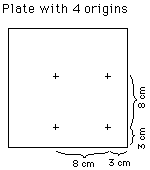Phosphoamino acid analysis:Mark Kamps method
互联网
Phosphoamino acid analysis:Mark Kamps's method
1. Label your protein with 32Pi. Then subject the protein to SDS polyacrylamide gel electrophoresis and transfer your gel-fractionated protein to Immobilon-P .
 Neither nitrocellulose nor nylon will work!
Neither nitrocellulose nor nylon will work!
- Keep the membrane wet and wrap in Saran wrap.
- Add radioactive markings for orientation of film later
- Expose to film.
2. Cut out band of interest, re-wet in methanol, rinse well in water and place in a screw-cap tube containing 150 µl 5.7 N HCl or enough to submerge your piece of membrane.
3. Incubate in 110°C oven for 60 min.
4. Microfuge sample full speed for at least 1 min.
5. Transfer supernatant to new tube and lyophilize on Speedivac. (It takes about 3 hr.)
6. Resuspend in H2O, and microfuge 5 min. Spotting more than 3 µl is tedious, so don't use much H20. On the other hand, I wouldn't use much less than 6 µl so as to have good recovery.

7. Spot 1 µl PAA standards (about 0.3 µg each of PSer, PThr, and PTyr) on a cellulose thin layer chromatography plate and then spot your sample. We use 0.1 mm EM cellulose plates
-
You can spot the whole sample if you are skillful and have no choice because you don't have many counts.
Spot 0.25-0.30 µl at a time and dry with house air, blown through a plugged pipet, between applications.
8. Electrophorese at pH 1.9, 1.5 KV, 20 min in the first dimension.
9. Let plate air dry well.
10. Rotate 90° counter clockwise. Electrophorese at pH 3.5, 1.6 KV, 13 min in the second dimension.
11. Dry plate in oven.
12. Spray plate with ninhydrin sol'n for several seconds. Incubate in oven until can see purple spots of PAA standards. 15 min should be plenty.
13. Mark the plate with radioactive ink so that you can extrapolate where the origins were and can align the film unambigously with the plate and the PAA markers.
14. Expose the plate to flashed film with a screen a -70°C. Film is much preferable to the phosphorimager because it is transparent and is exactly the same size as the plate and this facilitates alignment of the film and the plate. In the rare case that you need quantification, you can use the phosphorimager.
15. After developing the film, trace the locations of the PAA standards and the radioactive ink marks onto a Xerox transpancy and save this in your notebook.
This is what a perfect plate looks like.

Recipes:
In general, you will need 2 liters of each buffer.
 pH 1.9 buffer.
pH 1.9 buffer.
88% Formic acid 50 ml Acetic acid 156 ml H2O 1794 ml
Don't use the 98% formic acid and don't adjust the pH.
Don't bother to adjust the pH.
![]() There have been occasional problems with badly smeared PAAs during electrophoresis at pH 3.5. Something seems to leach out of the wicks and make the PAAs relatively insoluble. Tony thinks it is aluminum. Bart thinks that it's calcium. In any case, this problem can be prevented by including 0.5 mM EDTA in the 3.5 buffer.
There have been occasional problems with badly smeared PAAs during electrophoresis at pH 3.5. Something seems to leach out of the wicks and make the PAAs relatively insoluble. Tony thinks it is aluminum. Bart thinks that it's calcium. In any case, this problem can be prevented by including 0.5 mM EDTA in the 3.5 buffer.
If you want to refer to the original references for this technique, cite:


![DKFZ-PSMA-11,4,6,12,19-Tetraazadocosane-1,3,7-tricarboxylic acid, 22-[3-[[[2-[[[5-(2-carboxyethyl)-2-hydroxyphenyl]methyl](carboxymethyl)amin](https://img1.dxycdn.com/p/s14/2025/1009/171/0405943971658126791.jpg!wh200)







